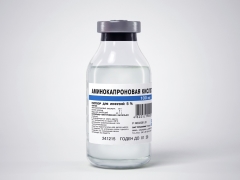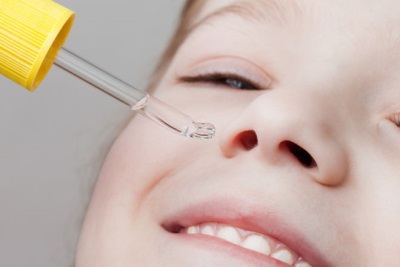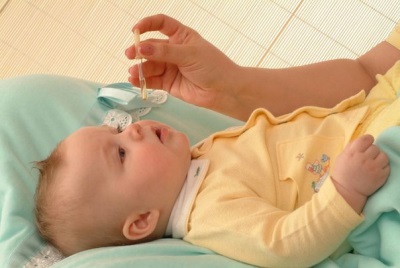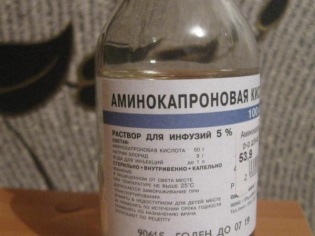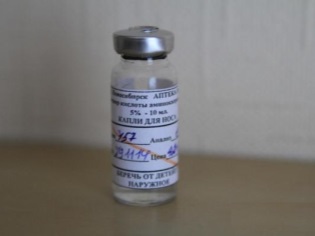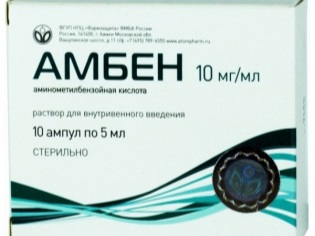The use of aminocaproic acid in the treatment of children
About aminocaproic acid is known as a fairly effective means to stop bleeding. However, in childhood this medicine can be used in a different way, for example, to dig into the nose. Is it possible to treat young children with aminocaproic acid, what indications are there for the use of such a drug in children, and also how to wash the nose with an aminocaproic acid and how to inhale with such a drug?
Release form
Aminocaproic acid is produced in the form:
- Powder or granules. Such aminocaproic acid is distinguished by its white color and the absence of both taste and smell. It is easily dissolved in water, forming a solution of a given concentration.
- 5% solution. It is packaged in bottles with a capacity of 100 ml and 250 ml, as well as in plastic bags or containers with volumes from 100 to 1000 ml. Each milliliter of such a clear, colorless liquid contains 50 mg of active substance.
Composition
The main component of the drug is aminocaproic acid. Besides it, only sterile water is present in the solution, as well as sodium chloride.
Operating principle
Once in the patient's body, aminocaproic acid affects the blood coagulation process.. In particular, it affects the formation of fibrinolysin, inhibiting activators responsible for this process. It is this effect of the drug that causes its hemostatic effect.
In addition, the drug makes capillaries less permeable and has an activating effect on platelets.. In aminocaproic acid, a positive effect on the work of the liver in the disposal of toxins is also noted.
Watch the video, which describes the properties of aminocaproic acid and chlorhexidine:
When instilled into the nasal passages, aminocaproic acid:
- Reduces the production of pathological secretions in the common cold.
- Helps to reduce swelling of the mucous.
- Reduces the inflammatory process.
- Strengthens blood vessels in the nose.
- It has some antiviral and antiallergic effects.
If aminocaproic acid is taken orally, the drug is well absorbed and after 1-2 hours its concentration in plasma will be maximum. After intravenous administration, the effect of the drug appears after 15-20 minutes.
The kidneys are predominantly involved in the removal of the drug from the body; therefore, the reduced function of this organ leads to a slowdown of excretion and a sharp increase in the amount of aminocaproic acid in the bloodstream.
Indications
Since Aminocaproic acid is a hemostatic drug, bleeding is the most common indication for its use. The drug can be prescribed and when the bleeding has already begun, and in order to prevent it. Such a drug is especially in demand in surgery if an operation is planned or performed on the stomach, thyroid gland, lungs and other organs in which there are many fibrinolysis activators. Aminocaproic acid is also prescribed to patients who have received large amounts of blood.
To drip Aminocaproic acid in the nose is recommended in such cases:
- With ARVI, a symptom of which is rhinitis.
- With allergic rhinitis.
- When bleeding from the vessels of the nose.
- When sinusitis.
- In the initial stage of the adenoids.
- To prevent viral infections in the season of influenza and acute respiratory infections.
At what age is it allowed to take?
Treatment of children with aminocaproic acid is possible from birthHowever, the appointment of this medicine to babies of the first year of life should be carried out by a pediatrician.
It is unacceptable to use aminocaproic acid for children under one year without consulting the doctor and individually determining the desired dosage.
Contraindications
Instructions for use prohibits or limits the treatment with aminocaproic acid if:
- There are problems with blood circulation, in which blood clots appear in the blood or emboli are detected.
- Renal failure detected.
- Seriously impaired liver function.
- Identified intolerance drugs.
- Tests showed blood in the urine.
- The patient has a serious heart disease.
- Diagnosed with circulatory disorders in the brain.
- Reduced blood pressure.
Side effects
The drug is rapidly eliminated from the body, and its toxic effect at the correct dosage is minimal, however, in some patients, treatment with aminocaproic acid leads to:
- Skin rashes.
- Acute renal failure.
- The appearance of vomiting, nausea, or loose stools.
- Headaches.
- Nasal congestion.
- Decreased blood pressure.
- Dizziness.
- The destruction of muscle tissue.
- Orthostatic hypotension.
- Cramps.
- Subendocardial hemorrhage.
With the appearance of such symptoms, for example, vomiting or skin rash, the dosage of aminocaproic acid is reduced or the treatment with this drug is refused. If during instillation of the nose the medicine accidentally gets into the eye, you should immediately flush the mucous membrane and, if the child has complaints from his eyes, contact an ophthalmologist.
Instructions for use
Methods of administration
Aminocaproic acid can be used:
- For intravenous injections. This method is most in demand for acute bleeding, as well as during surgical treatment.
- For oral administration. This use of the drug is indicated not only for bleeding, but also for rotavirus.
- For instillation into the nose. Powdered or granulated Aminocaproic acid mixed with a non-sweetened water is used both as a ready-made solution and Aminocaproic acid (a 5% solution is also prepared from this form of medicine).
- For inhalation. Procedures are performed with a nebulizer for adenoids, for coughing, as well as for a long run of cold or for sinusitis.
- For rinsing the nose. Such manipulation is sometimes prescribed to remove yellow or green thick nasal secretions. In this case, the lavatory must be carried out by a doctor, since an incorrect procedure may cause increased edema and irritation of the mucous membrane.
Dosage
- For the treatment of rhinitis In each of the nasal passages of the child, you must enter one or two drops of liquid aminocaproic acid, if the doctor did not recommend a different dosage. The instillation is repeated every 3 hours, and the treatment lasts from three to 7 days.
- To warn ARVI during the epidemic season, two or three drops of aminocaproic acid in liquid form can be injected into the child's nostrils up to 5 times a day.
- Per inhalation Aminocaproic acid solution is taken in a volume of 2 ml, mixed with the same amount of sodium chloride solution. The frequency of the procedure - twice a day for 5-10 minutes, and the average duration of therapy is 4 days.
- Into the vein Aminocaproic acid is administered driply, mixing the medicine with saline before the infusion. The daily dosage for babies up to one year is 3 grams of the active substance, at the age of 2 to 6 years - from 3 to 6 grams of aminocaproic acid, at 7 years and older - from 6 to 9 grams of the active ingredient. If the blood loss is acute, the dosage is doubled.Treatment continues for three to 14 days depending on the pathology.
- Inside the drug is given to drink at a dosage of 100 mg per 1 kg of baby’s weight, and then every hour until the bleeding stops at a dose of 33 mg of aminocaproic acid per kilogram of the patient’s body weight.
Overdose
If the tolerated dose of aminocaproic acid is exceeded, this will lead to an increase in adverse reactions, as well as the formation of blood clots. Prolonged use of such a drug in a high dose provokes hemorrhages.
Interaction with other drugs
When administered simultaneously with antiplatelet agents or any anticoagulants, the effect of aminocaproic acid is reduced.
Terms of sale
The medicine is sold by prescription. The price of one bottle with 100 ml of aminocaproic acid is on average 50-60 rubles.
Storage conditions and shelf life
Aminocaproic acid vial is recommended to be stored at a temperature not higher than + 25 ° C in the reach of children, and the shelf life of the medication is 2 years.
Reviews
ENT doctors speak about Aminocaproic acid well and have been using this drug for years in the treatment of various ENT pathologies. They note the effectiveness of this remedy for viral rhinitis, inflammation of the nasal mucosa, sinusitis, as well as nosebleeds. They are attracted by the fact that, in comparison with other preparations for rhinitis, Aminocaproic acid does not dry the mucous membrane and does not provoke vasoconstriction.
Most moms who used aminocaproic acid for rhinitis for treatment or prophylactic purposes also leave positive feedback. They note a fairly quick action when rhinitis, affordable cost of medication, as well as safety for the child. The disadvantages of using a head cold are the difficulties of administering the drug to the nose, since Aminocaproic acid is sold without a pipette, and the bottle opens inconveniently.
Analogs
If the reason to use aminocaproic acid is bleeding, then the drug can be replaced with other hemostatic drugs. An example might be Tranexam or Amben.
If, for some reason, treatment of rhinitis with aminocaproic acid is not possible, you can bury the child’s nose with such drugs:
- Pinosol, Eucasept and other oil drops. Dr. Komarovsky speaks positively about such drugs in the treatment of rhinitis.
- Aqua Maris, Marimer, Aqualore Baby and other preparations based on seawater or sodium chloride.
- Otrivin, Nazivin, Tizin and other vasoconstrictor medicines for rhinitis.
